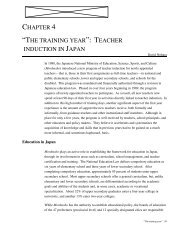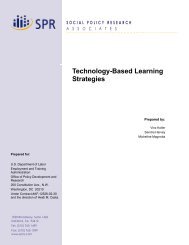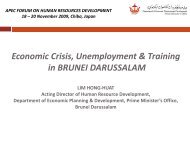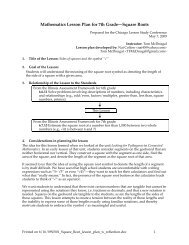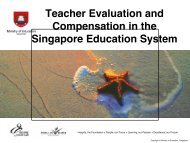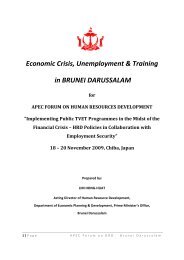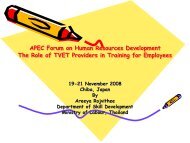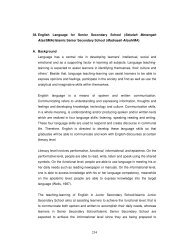Quality Assurance Systems in Asia-Pacific Economic Cooperation
Quality Assurance Systems in Asia-Pacific Economic Cooperation
Quality Assurance Systems in Asia-Pacific Economic Cooperation
Create successful ePaper yourself
Turn your PDF publications into a flip-book with our unique Google optimized e-Paper software.
ENHANCEMENT OF QUALITY ASSURANCE SYSTEMS IN HIGHER EDUCATION IN APEC MEMBER ECONOMIES<br />
Internal QA Processes<br />
All quality assurance practices of the APEC region emphasise and recognise the value of an<br />
analytical and self critical process be<strong>in</strong>g undertaken by those who undergo the external QA<br />
process. Usually, a set of standards and criteria, pre-determ<strong>in</strong>ed by the quality assurance<br />
system, forms the basis for the self-assessment report. There are generally national<br />
consultations to ensure wide participation of the stakeholders <strong>in</strong> evolv<strong>in</strong>g the standards and<br />
criteria. The <strong>in</strong>stitution (or program) undergo<strong>in</strong>g the process is asked to do a self-assessment<br />
and report on how it meets the standards set or criteria identified for the quality assurance<br />
procedure.<br />
The level of detail and analysis provided by the <strong>in</strong>stitution/program varies. Some systems<br />
offer a lot of flexibility to design their self-assessment and the consequent report. Many<br />
agencies assist HEIs by organis<strong>in</strong>g tra<strong>in</strong><strong>in</strong>g programs that guide the preparation of a good<br />
self-assessment report.<br />
The QA agencies follow a multi-pronged approach to dissem<strong>in</strong>at<strong>in</strong>g the QA policies and<br />
practices. They publish manuals, guidel<strong>in</strong>es and booklets on QA procedures. Many of them<br />
run tra<strong>in</strong><strong>in</strong>g programs, organise fora for discussions, offer consultancy services, and arrange<br />
for brief<strong>in</strong>g/ explanatory/ orientation programs.<br />
Only <strong>in</strong> a few systems, preparation of the self-assessment reports is solely an activity of the<br />
adm<strong>in</strong>istrative staff. In most systems, teach<strong>in</strong>g staff are <strong>in</strong>volved. Mostly the self-assessment<br />
report is the major <strong>in</strong>put to the external QA process, although many QA agencies consider<br />
government reports and reports of professional organisations. Some consider the media<br />
reports and a few others consider <strong>in</strong>formation received from the public. Survey results are<br />
also used.<br />
External QA Processes<br />
External review is one of the critical elements, similar to self-assessment that has evolved as<br />
an <strong>in</strong>tegrated component of quality assurance <strong>in</strong> the APEC region. When the <strong>in</strong>stitution<br />
submits the self-assessment report, a team of external reviewers is constituted to analyse the<br />
report of the <strong>in</strong>stitution and to validate the claims made there<strong>in</strong>, generally by visit<strong>in</strong>g the<br />
<strong>in</strong>stitution.<br />
Profile and Responsibilities of Reviewers<br />
The survey <strong>in</strong>dicates that the predom<strong>in</strong>ant profile of reviewers is subject specialisation and<br />
expertise <strong>in</strong> general higher education. Some systems consider representatives of employers<br />
and <strong>in</strong>dustry. A few others consider representatives from professional organisations. Involv<strong>in</strong>g<br />
students <strong>in</strong> review panels does not seem to be <strong>in</strong> practice. A couple of the QA systems<br />
<strong>in</strong>volve graduates or alumni of the <strong>in</strong>stitution.<br />
Most QA systems ma<strong>in</strong>ta<strong>in</strong> a register or pool of reviewers from which to choose the panel for<br />
a specific review. A couple of the QA units that carry out specific QA functions for the<br />
m<strong>in</strong>istries do not ma<strong>in</strong>ta<strong>in</strong> a register but develop a list of reviewers depend<strong>in</strong>g on the need of<br />
the review.<br />
Identify<strong>in</strong>g the Reviewers<br />
To identify people who have the necessary abilities, the quality assurance agencies of the<br />
APEC region seem to rely heavily on nom<strong>in</strong>ations and <strong>in</strong>formal ways of identify<strong>in</strong>g the<br />
reviewers but supplement them with tra<strong>in</strong><strong>in</strong>g and evaluation. For the nom<strong>in</strong>ations, by self or<br />
by others such as the QA staff and govern<strong>in</strong>g board, some QA systems have thorough<br />
procedures <strong>in</strong> place to ensure the academic credibility, <strong>in</strong>tegrity and skills of the nom<strong>in</strong>ees.<br />
The survey <strong>in</strong>dicates that <strong>in</strong> most cases the reviewers are appo<strong>in</strong>ted to the panel by the<br />
govern<strong>in</strong>g board or by the Executive of the QA system.<br />
Tra<strong>in</strong><strong>in</strong>g Reviewers<br />
The professionalism with which the review panel can function is very important to<br />
uphold/ma<strong>in</strong>ta<strong>in</strong> the credibility of the QA process. Even the most highly qualified team can be<br />
thwarted <strong>in</strong> its work if the review panel is not oriented properly to its tasks. To address these<br />
concerns, many quality assurance systems have <strong>in</strong> place, various safeguards and protocols<br />
xiv



